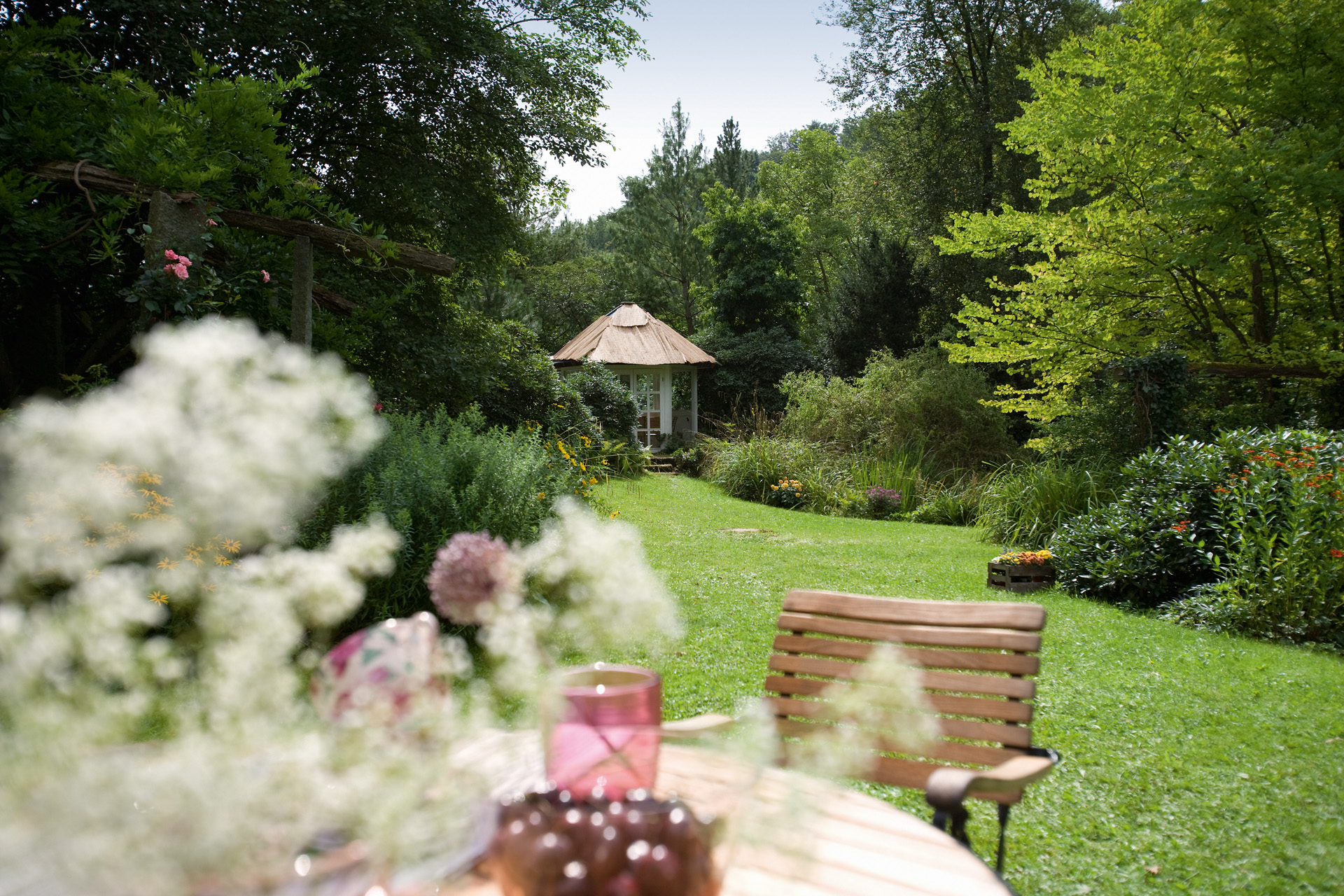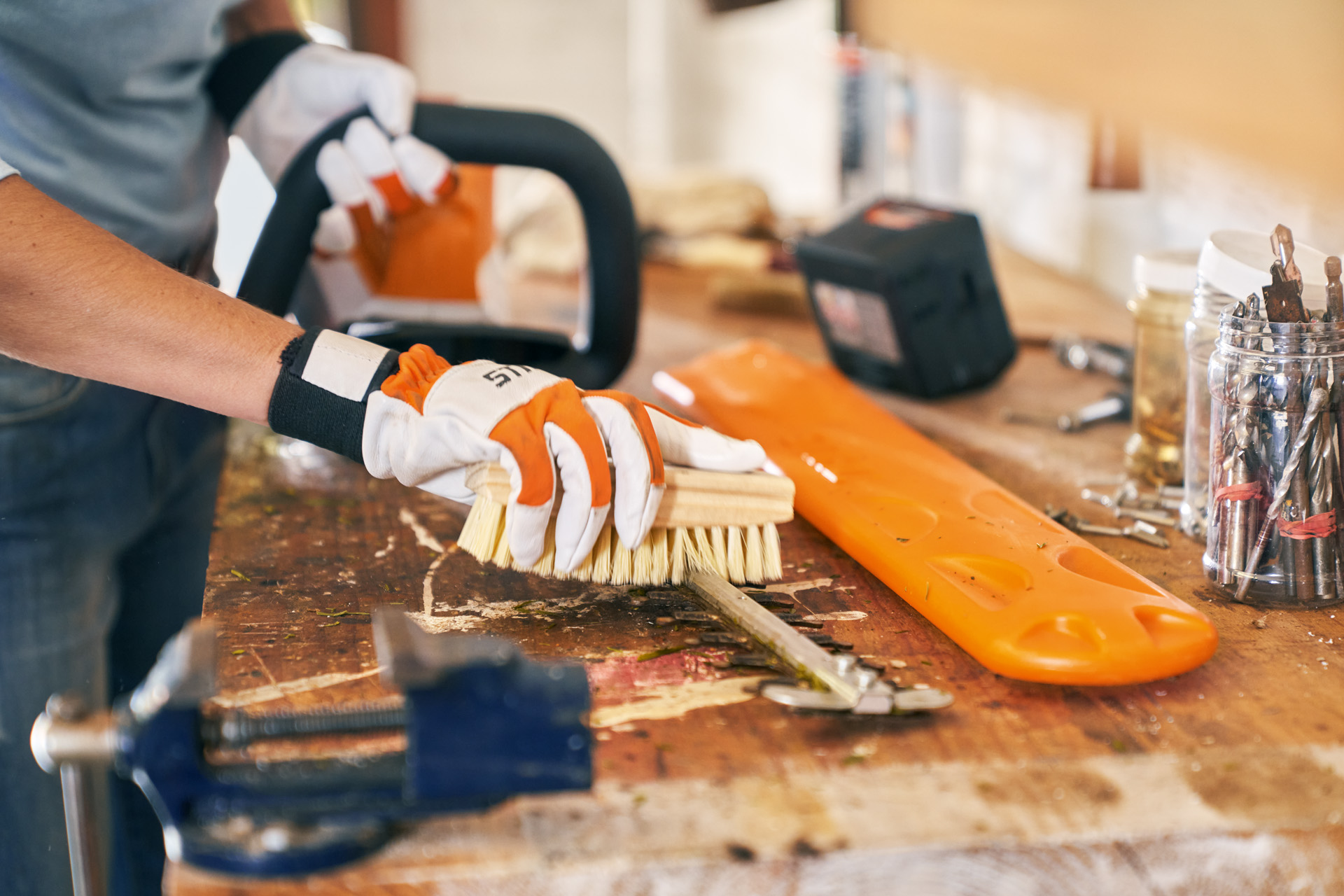Fallen leaves: clearing them and making use of them in your garden
Gardeners face the mess of fallen leaves every year. Find out the best way of clearing them efficiently, and even how they can be useful in your garden.
11.07.2023

Why do I need to clear fallen leaves in my garden?
Colourful autumn leaves are a seasonal joy in gardens, and they don’t actually cause any problems on their own. However, once you add in the weather that also comes with the time of year, cold and wet leaves become a slip hazard. In your garden, leaving a layer of leaves on the ground can be harmful to some plants too.
Clearing leaves: where you need to do it
Because of the risk of slipping, clearing leaves is particularly important on pavements, patios, decking and driveways. To keep your lawn healthy, we also recommend regularly clearing leaves from the grass.
Leaves on your lawn
Don’t let fallen leaves lie on your lawn for too long before clearing them, as they block light and air from your grass plants. Moisture often collects under the layer of leaves, causing them to rot, which can leave light or dark stains on the lawn, bare patches or increased moss formation. So clearing leaves from your lawn should be a regular task during the cooler months – a leaf blower can help make removal easy.
Leaves under trees and shrubs and elsewhere in your garden
Fallen leaves under trees and shrubs are actually very beneficial for the soil, so you can go without clearing here and allow a leaf layer up to 15 cm thick to form – this will break down to become valuable, fertile soil. Similarly, having leaves on your vegetable beds can protect the delicate soil from frost and regulate the moisture balance during the cold season. However, remember that plants with soft shoots, grasses and evergreens cannot tolerate being covered by leaves.
If leaves from your trees blow onto a neighbour’s plot
In theory, any leaves that fall and stay on your plot are your responsibility, and so you need to take care of sweeping and disposal. If an excessive number of leaves are coming from your neighbour’s plot, try to come to an amicable arrangement. There is generally no prospect of legal recourse unless the leaves cause clear damage – and even then, legal cases are rarely straightforward.
Slip hazard from leaves
Always keep paths clear of fallen leaves as they will quickly become slippery when wet and may become a serious hazard for pedestrians and cyclists. It's likely that your local council is ultimately responsible for the pavement, so contact them if you need to find out about their clearing schedule.
How to clear leaves
Clearing leaves: using a rake
A rake is the simplest and most affordable way of dealing with fallen leaves. It does require some effort though.
Clearing and collecting leaves with your lawn mower
A simple way to clean up and collect is with your lawn mower – in terms of effort required, it’s a good compromise between a rake and a leaf vacuum. Simply run your lawn mower over the leaves, and it will collect them in the grass collection box or bag.
Clearing leaves: leaf blowers make light work
Blowers are a quick and reliable way of clearing spaces by collecting large quantities of leaves into a neat pile. These powerful assistants are ergonomically designed and ideal for larger plots.

Clearing leaves: using a vacuum shredder
A vacuum shredder takes less effort and is easier to use than a rake. It also chops the leaves into small pieces as it picks them up and gathers them in a bag. This is an efficient option, whether you need to dispose of the leaves or use them later for mulch.
When can I use a vacuum shredder?
Like most power tools, vacuum shredders can be noisy. Take care not to use them at unsociable times that may disturb your neighbours. Noise regulations are set by local councils in Great Britain so it's worth being aware of any local restrictions.
Tool expertise: blowers and vacuum shredders
Make clearing gardens and outdoor spaces quick and efficient with powerful STIHL leaf blowers and vacuum shredders. Fierce autumn winds may blow leaves everywhere, but you can get them under control in no time with just a bit of raking, vacuuming and shredding.

Blowers sort it quickly
Powerful, hand-held blowers from STIHL turn a laborious raking job into quick and easy work. They make clearing wet or dry leaves in your garden simple and are relatively quiet to use.

Vacuum shredders chop garden waste on the spot
Vacuum shredders are machines that work like household vacuum cleaners, making easy work of leaf collection. The main advantage is that they collect leaves while clearing and also pass them through an internal cutting mechanism. This chops leaves and lightweight garden waste on the spot.
Clearing leaves: advantages of blowers and vacuum shredders
| Type of tool | Advantages |
|---|---|
| STIHL cordless blowers |
|
| STIHL electric blowers |
|
| STIHL petrol blowers |
|
| STIHL electric vacuum shredders |
|
| STIHL petrol vacuum shredders |
|

Disposal of leaf waste
Disposing of small amounts of leaves
After clearing leaves, they shouldn’t go into your household waste, but you can certainly put them into a garden waste bin or compost heap if you have one.
Disposing of large amounts of leaves
If you have too many leaves for your garden waste bin, find out what local provision exists. Some councils sell special green waste sacks that they will collect, or there may be a local recycling centre or tip where you can drop them off. You may need to look into a commercial waste collection service if your council cannot help.
Clearing leaves: how not to dispose of them
In the woods: Do not dump leaves in woodland under any circumstances, as this could disturb the sensitive ecosystem of the forest. Such disposal is counted as fly-tipping and can be prosecuted as such.
On the street: Leaving your collected leaves at the roadside is also illegal fly-tipping.
Burning: Although garden bonfires are not prohibited, they can be considered a nuisance. If leaves are damp, burning them will generate a huge amount of smoke that can be hazardous in various ways. We do not recommend burning leaves after clearing them.
Making use of collected leaves
In some places, clearing is not necessary, as fallen leaves can actually be beneficial to the nature around them and should be left in some parts of the garden. You can use them to nourish the soil directly, as frost protection mulch or as a habitat for wildlife. And even if you are clearing leaves from your paths and lawn, you can also make use of the same advantages and harness the goodness from the waste elsewhere in your garden

Leaves can be left as mulch on flowerbeds and under shrubs to provide natural frost protection for plants in winter – you can even heap up the leaves in these areas while you’re clearing them from your lawn. If you have frost-sensitive roses or gladioli, cover the base with a thick layer of leaves. As the leaves rot over time, they will provide valuable nutrients to the soil.
You can cover your vegetable beds with leaves too, although you shouldn’t layer them too thickly there. Ideally, loosen up the soil first so that you can work the leaves into it a little – even a light covering of earth will accelerate the leaves’ decaying process, and so they can nourish the soil even more quickly.
You could take a partial approach to clearing leaves, removing them from your lawn but keeping them gathered together in certain areas of your garden. Hedgehogs and other small garden animals are always happy to see large piles of leaves, as they provide a shelter in which to hibernate. And you should be glad if you see them too – hedgehogs gobble up pests like snails and will also loosen the soil.
If you don’t have enough room to put all your leaves on the compost heap, you can easily make leaf mould, which is an excellent soil conditioner. You can buy leaf bags to put them in, or just put them into a black bin bag and punch some holes in the sides. If you can shred them first, they’ll take up much less space and break down quicker too. Add some water, stow them in a discreet corner where they are open to the elements, and after a year or so, they will have broken down to become an excellent soil conditioner.
You could also create a compost bin or even just a dedicated corner for leaves to become leaf mould on a larger scale. The simplest way is to drive four wooden posts into the ground and wrap some wire mesh around them. You’ve made a ventilated leaf store that will be great for your garden!
Summary: clearing leaves
- Clearing leaves from paths is important to prevent accidents, and it will keep your lawn healthy and your garden looking great.
- You can use a rake, vacuum shredder, lawn mower or blower.
- You can dispose of small amounts of leaves in a garden waste bin if you have one.
- For larger amounts, find out about local composting and waste disposal provision.
- Use leaves as compost, fertiliser or a winter home for wildlife.


